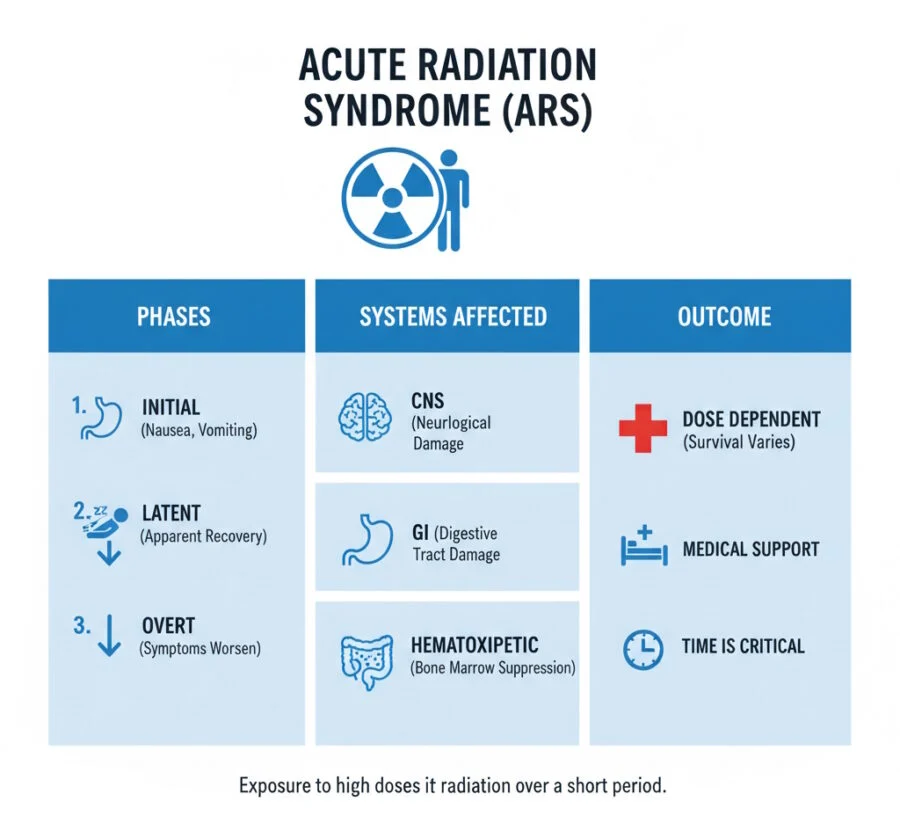Acute Radiation Syndrome (ARS), commonly referred to as radiation sickness or radiation poisoning, is a serious and potentially life-threatening condition that arises from exposure to high levels of ionizing radiation over a short period.
What is Acute Radiation Syndrome?
ARS is an acute illness triggered by irradiation of the entire body (or a significant portion) with a high dose of penetrating radiation, typically in minutes to hours. It results from the depletion of immature stem cells in key tissues, leading to multisystem failure if untreated. Unlike chronic radiation exposure, which may cause long-term effects like cancer, ARS manifests rapidly and can be fatal at high doses.
To develop ARS, four criteria must be met:
- The radiation dose must be high (typically >0.7 Gy or 70 rads, though mild symptoms can occur at 0.3 Gy).
- The radiation must be penetrating (e.g., gamma rays, neutrons, or high-energy X-rays) to reach internal organs.
- Most or all of the body must be exposed.
- The exposure must occur over a short time frame, usually minutes.
ARS encompasses four subsyndromes based on the affected systems:
- hematopoietic (blood-forming),
- gastrointestinal (GI),
- cutaneous (skin),
- neurovascular (brain and cardiovascular).
These can overlap, with severity depending on dose, exposure rate, and individual factors like age or health status. It’s rare in everyday life but has occurred in nuclear accidents and medical mishaps.
Causes and risk factors
ARS is caused by exposure to ionizing radiation from sources such as:
- Nuclear accidents (e.g., Chernobyl in 1986 or Fukushima in 2011).
- Atomic bomb detonations (e.g., Hiroshima and Nagasaki in 1945).
- Medical errors, like radiotherapy overdoses or mishandled radioactive materials.
- Industrial incidents involving irradiators or criticality accidents.
- Intentional acts, such as radiological terrorism or poisoning (e.g., suspected polonium cases).
Risk factors include:
- Occupation: First responders, nuclear workers, or medical personnel handling radiation.
- Proximity to radiation sources without protection.
- Vulnerable populations: Children, pregnant individuals, and those with compromised immune systems may experience worse outcomes.
- Dose fractionation: Split doses allow some recovery, reducing ARS risk compared to single, acute exposures.
Alpha and beta particles cause skin burns but not ARS unless ingested; gamma and neutron radiation are the primary culprits due to their penetration.
Symptoms and phases of ARS
ARS progresses through four distinct phases, with symptoms varying by dose and subsyndrome. Early signs are nonspecific, mimicking flu or food poisoning, but rapid onset post-exposure is a clue.
Prodromal phase
Begins minutes to days after exposure. Symptoms include nausea, vomiting, diarrhea, headache, fatigue, fever, and anorexia. Higher doses cause faster, more severe onset—e.g., vomiting within 30 minutes at >6 Gy affects 100% of victims. This phase lasts minutes to days.
Latent phase
A temporary “well” period where symptoms subside. Duration varies: weeks for lower doses, hours for high doses. Patients feel healthy but underlying damage progresses.
Manifest illness phase
Critical stage with organ-specific symptoms. Lasts hours to months.
- Hematopoietic subsyndrome (0.7–10 Gy): Blood cell depletion leads to infections, bleeding, anemia, fever, and malaise. Death from sepsis or hemorrhage if untreated.
- Gastrointestinal subsyndrome (6–30 Gy): Severe diarrhea, dehydration, electrolyte imbalance, and abdominal pain. Villi loss disrupts absorption; microbiome dysbiosis worsens inflammation.
- Neurovascular subsyndrome (>30 Gy): Neurological issues like dizziness, seizures, coma, and cardiovascular collapse. Almost always fatal.
- Cutaneous effects: Skin redness, itching, blistering, ulceration, and hair loss (epilation by day 11 at >6 Gy).
Recovery or death phase
Recovery may take weeks to years with supportive care; otherwise, death occurs from multi-organ failure.
For a visual overview, here’s a table summarizing symptoms and outcomes by whole-body dose (adapted from established guidelines):
| Dose Range (Gy) | Prodromal Symptoms (Onset) | Latent Phase Duration | Manifest Symptoms | Mortality Without Care | Mortality With Care |
|---|---|---|---|---|---|
| 1–2 | Mild nausea/vomiting (2–6 hrs, 5–50%) | 2–6 weeks | Mild blood cell drop, infections | 0–5% | Near 0% |
| 2–6 | Moderate nausea/vomiting (1–2 hrs, 70–90%) | 1–3 weeks | Severe anemia, bleeding, fever | 5–95% | 5–50% |
| 6–8 | Severe vomiting (<30 min, 100%), heavy diarrhea (1–3 hrs) | <1 week | GI bleeding, infections, epilation | 95–100% (1–2 weeks) | 50–100% |
| 8–30 | Immediate vomiting, severe headache/fever | Hours | Massive GI damage, dehydration | 100% (days) | 90–100% |
| >30 | Immediate neurological symptoms, no vomiting | Minutes | Coma, convulsions | 100% (hours-days) | 100% |
This table highlights how higher doses accelerate progression and worsen prognosis.
Diagnosis of ARS

Diagnosis relies on exposure history, clinical signs, and lab tests, as no single marker confirms ARS.
- History and physical exam: Note time since exposure, symptoms like vomiting onset (predicts dose), and skin changes.
- Blood tests: Serial complete blood counts (CBCs) every 2–6 hours to track lymphocyte depletion using tools like the Andrews Lymphocyte Nomogram. Low lymphocytes within 48 hours indicate >1 Gy.
- Cytogenetic bioassay: Gold standard for dose estimation via chromosome aberrations (e.g., dicentrics).
- Radiation detection: Geiger counters for contamination; biodosimetry for absorbed dose.
- Imaging: CT or MRI for organ damage if needed.
Triage in mass casualties prioritizes those with moderate symptoms for treatment.
Treatment and management
No cure exists for ARS, but prompt supportive care improves survival.
- Decontamination: Remove clothing and wash skin to prevent further exposure.
- Supportive care: IV fluids, electrolytes, antiemetics, pain relief, and antibiotics for infections. Blood transfusions or platelet support for hematopoietic issues.
- Countermeasures: Granulocyte colony-stimulating factors (G-CSF) like filgrastim to boost white cells. Potassium iodide blocks thyroid uptake of radioactive iodine.
- Advanced therapies: Bone marrow or stem cell transplants for severe hematopoietic syndrome (doses 2–10 Gy).
- Experimental for GI: Anti-ceramide agents or FGF2 to protect endothelium.
- Hospitalization: In specialized units with isolation to prevent infections.
Psychological support addresses trauma, and long-term monitoring is essential for survivors.
Prognosis and complications
Prognosis depends on dose: LD50 (lethal dose for 50%) is 4–5 Gy without care, improving to 6–7 Gy with treatment. Low doses (<2 Gy) often allow full recovery; >8 Gy is usually fatal. Complications include infections, organ failure, cancer (e.g., leukemia), cataracts, and infertility. Survivors may face chronic fatigue or psychological issues.
Prevention strategies
Prevent ARS through:
- Safety protocols in nuclear facilities and medical settings.
- Personal protective equipment (PPE) and dosimetry badges.
- Evacuation and sheltering in emergencies.
- Public education on radiation risks.
Historical cases and epidemiology
ARS is rare, with notable cases from Hiroshima/Nagasaki (tens of thousands affected), Chernobyl (134 confirmed ARS cases, 28 deaths), and Tokaimura (1999, severe skin loss in one victim). Epidemiology shows higher risks in occupational settings, but global incidents are infrequent.
Recent advancements (as of 2025)
Research focuses on GI-ARS mechanisms, identifying isthmus progenitor cells as key for intestinal regeneration. Ceramide pathways drive apoptosis; inhibitors show promise. Gut-on-a-chip models aid drug testing, and TP53-mediated “fetal-like” reversion in cells offers new therapeutic targets. No FDA-approved GI-ARS drugs yet, but studies emphasize vascular regeneration and stem cell hierarchies.
FAQ about ARS syndrome
- Is ARS contagious?
No, once decontaminated, affected individuals pose no risk to others.
- Can ARS be reversed?
Not fully, but early treatment can lead to recovery at lower doses.
- What if I suspect exposure?
Seek immediate medical help; monitor for symptoms and get tested.
- Are there long-term effects for survivors?
Yes, increased cancer risk and organ damage; regular follow-ups are crucial.
- How does ARS differ from chronic radiation effects?
ARS is acute and systemic; chronic involves gradual damage like mutations.
For more resources, visit sites like CDC or REMM, that are available down below in our sources section.
